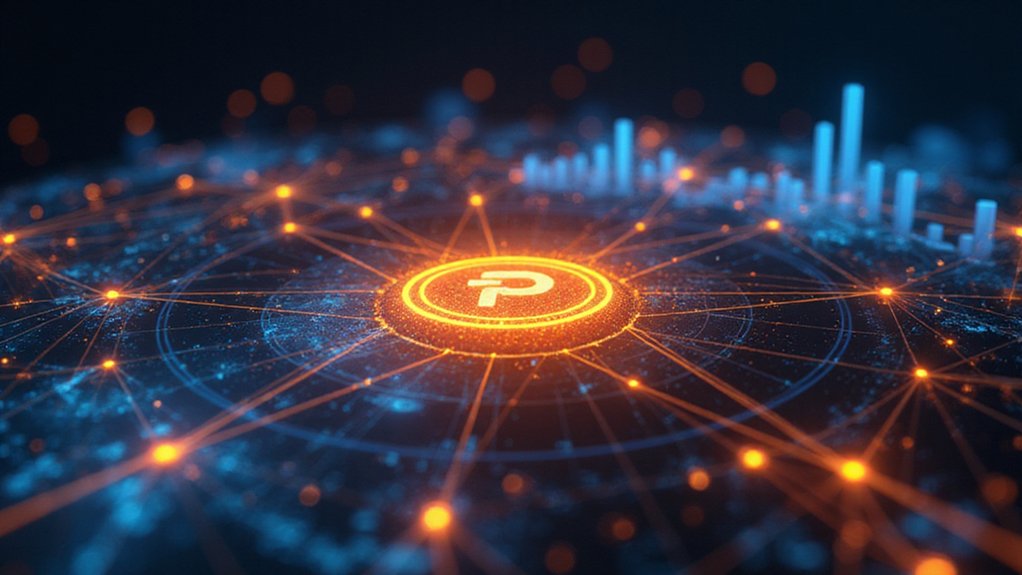Avalanche has turbocharged blockchain performance with its tri-chain architecture, processing a staggering 6,500 transactions per second—433 times Ethereum’s capacity—with sub-second finality. Its subnet framework enables purpose-built blockchains that maintain cross-ecosystem liquidity through Avalanche Warp Messaging, all while consuming electricity equivalent to just 46 US households annually. This technical marvel deftly navigates the notorious blockchain trilemma, positioning Avalanche as a formidable bridge between traditional finance and crypto’s promising frontier.

The Avalanche blockchain network, a formidable contender in the increasingly crowded layer-1 protocol landscape, has emerged as one of the most architecturally sophisticated distributed ledger ecosystems since its 2020 launch. Its tripartite foundation—comprising the Exchange Chain (X-Chain), Contract Chain (C-Chain), and Platform Chain (P-Chain)—represents a radical departure from single-chain architectures that have historically plagued blockchain scalability efforts. Each chain serves a distinct function: X-Chain handles asset issuance and transfers, C-Chain executes smart contracts with Ethereum compatibility, while P-Chain orchestrates validator coordination and subnet management.
What distinguishes Avalanche in this labyrinthine crypto landscape is its remarkable transaction finality of under one second—a stark contrast to Ethereum’s sometimes glacial confirmation times. The network processes a staggering 6,500 transactions per second, an impressive feat achieved through its novel consensus protocol and directed acyclic graph structure. This throughput capability (nearly 433 times that of Ethereum’s current capacity) positions Avalanche as a genuinely viable infrastructure for mass-market financial applications. Similar to parallel processing techniques, Avalanche divides computational workload across multiple chains to achieve greater efficiency than sequential blockchain architectures. The platform also demonstrates an exceptional commitment to energy efficiency, consuming electricity equivalent to just 46 US households annually.
Interoperability—that elusive holy grail of blockchain architecture—forms the cornerstone of Avalanche’s strategic positioning. The network utilizes Avalanche Warp Messaging for native communication between its customizable L1s, enabling shared liquidity across the ecosystem. The C-Chain’s Ethereum Virtual Machine compatibility enables seamless migration of Solidity-based applications, while an extensive network of cross-chain bridges facilitates asset movement between previously siloed blockchain ecosystems. This cross-chain fluidity has catalyzed a flourishing decentralized application ecosystem spanning DeFi protocols, NFT marketplaces, and enterprise solutions.
Perhaps Avalanche’s most revolutionary contribution lies in its subnet architecture, allowing developers to create purpose-built blockchains with customized validation rules while maintaining interoperability with the broader network. These subnets effectively function as application-specific chains that can process transactions in parallel—a pragmatic solution to the blockchain trilemma of balancing security, decentralization, and scalability.
As traditional finance increasingly acknowledges blockchain’s transformative potential, Avalanche’s architectural sophistication positions it at the vanguard of protocols capable of bridging the chasm between crypto’s theoretical promise and practical, institutional-grade implementation.
Frequently Asked Questions
Is Avalanche a Good Investment for Beginners?
Avalanche presents a compelling case for neophyte investors—its user-friendly infrastructure, low transaction fees, and thorough educational resources reduce traditional crypto onboarding friction.
While offering significant technological advantages and passive income potential through staking, beginners should approach with calculated caution; cryptocurrency volatility remains an immutable reality.
The platform’s emphasis on accessibility and scalability positions it favorably compared to legacy blockchains, but novices would be prudent to limit initial exposure until thoroughly acclimated to market dynamics.
How Does Avalanche Compare to Ethereum for Developers?
For developers, Ethereum offers a battle-tested environment with extensive tooling and the largest developer ecosystem—advantages that shouldn’t be understated despite its transaction limitations.
Avalanche counters with EVM compatibility (allowing seamless code migration) while offering superior performance and customization through its subnet architecture.
The choice ultimately hinges on priorities: Ethereum provides established infrastructure and network effects, while Avalanche delivers enhanced performance and flexibility—particularly for projects requiring specialized blockchain configurations or transaction-intensive applications.
What Security Risks Exist Within the Avalanche Network?
Avalanche faces several security risks that warrant investor vigilance.
Smart contract vulnerabilities remain perhaps the most pressing concern, while the platform’s subnet architecture—though innovative—introduces cross-chain risks that can propagate vulnerabilities across the ecosystem.
Centralization threats persist despite the purported decentralization; a small validator cartel could theoretically undermine network integrity.
Additionally, operational risks (system failures, human error) and regulatory uncertainty loom over the network, potentially affecting its long-term security posture.
Can Avalanche Tokens Be Staked for Passive Income?
Avalanche tokens (AVAX) can indeed be staked for passive income generation.
Through the network’s Proof of Stake consensus mechanism, holders can earn rewards ranging from approximately 4.5% to 9% APY, depending on the staking platform chosen.
While potentially lucrative, stakers should consider the inevitable trade-offs: lock-up periods limiting liquidity, platform-specific counterparty risks, and the ever-present specter of market volatility affecting underlying token value.
Various services—Coinbase, Imperator, EarnPark—offer differing terms and security profiles.
What Regulatory Challenges Does Avalanche Face Globally?
Avalanche confronts a labyrinth of regulatory hurdles globally, from jurisdictional inconsistencies to evolving compliance frameworks.
The platform navigates GDPR complexities in Europe while facing uncertain stablecoin legislation in the US.
Regulatory uncertainty in emerging markets compounds these challenges, as authorities struggle to classify blockchain assets consistently.
Additionally, Avalanche must balance KYC/AML requirements with user privacy expectations—a delicate dance indeed, particularly as institutional adoption increases scrutiny of its governance and security protocols.









